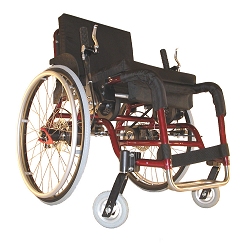Lynda Bennett
Have you ever tried to push yourself in a manual wheelchair? Did you know that the energy required to propel the chair forward (mechanical efficiency) is less than ten percent effective? How would you design a wheelchair that is easier and more efficient to move? The following is a summary of a mobility study that evaluated the mechanical efficiency of two types of lever-operated wheelchairs and then compared the results with those of a conventional hand rim wheelchair.
Original article: Lui, J., MacGillivray, M.K., Sheel, A.W., Jeyasurya, J., Sadeghi, M., Sawatzky, B.J. (2013). Mechanical efficiency of two commercial lever-propulsion mechanisms for manual wheelchair locomotion. Journal of Rehabilitation Research & Development, 50(10), 1363-72. Find the original article here.
What is a lever-propelled wheelchair?
In addition to hand rims, lever-propelled wheelchairs are equipped with levers to control velocity. Studies have shown that levers are better than hand rims because they require lower energy expenditure.
The researchers of this study evaluated the mechanical efficiency of the Willgo spring-lever wheelchair and the Wijit roller-lever wheelchair.
About the Willgo
The Willgo features two levers that are installed in front of each wheel. Pushing the levers forward engages a spring system that generates propulsion. The levers need to be retracted manually. The Willgo system can be installed on any wheelchair that meets the manufacturer’s specifications. Click for more information.
About the Wijit
The Wijit features two levers that are built into the hub of each wheel. Pushing the levers forward engages a roller system that generates propulsion. The levers retract automatically. The Wijit roller system is manufactured as part of the wheelchair. Click for more information.
What was measured?
The researchers of this study measured energy expenditure, and heart and lung response while participants used either the Willgo or the Wijit. The wheelchair was mounted on a treadmill and connected by a cable to measure the drag force. Participants wore a ventilator and were connected to heart-monitoring equipment to gather cardiopulmonary data.
What did the participants have to do?
The researchers recruited ten healthy, able-bodied adult males with no prior manual wheelchair experience. Before beginning each trial, the participants learned how to operate the respective wheelchair on the ground and on a treadmill. They participated in two sessions that occurred on different days. The condition was randomly selected from one of the following four scenarios:
- Lever propulsion system using the Wijit roller-lever system.
- Lever propulsion system using the Willgo spring-lever system.
- Hand rim propulsion with the Wijit roller-lever system disengaged.
- Hand rim propulsion with the Willgo spring-lever system disengaged.
Each trial consisted of three four-minute exercises at five-minute intervals. The treadmill was set at a constant speed. For the first exercise, the treadmill was level and the participant propelled the wheelchair forward. For each subsequent exercise, the treadmill’s slope was increased by one degree. The researchers measured the drag force and the participants’ physiological response in each exercise.
What was the most important finding?
This research indicates that using a lever-operated wheelchair to generate propulsion is easier and more mechanically efficient than using a hand rim operated wheelchair. The results suggest that it may be beneficial to consider testing a lever-operated wheelchair when shopping for a new wheelchair.
The research revealed some interesting details:
- Using the levers on the Wijit roller-lever wheelchair to propel the wheelchair forward was more efficient on treadmill slopes (angles of 1 and 2 degrees) than using the hand rims.
- Using the levers on the Willgo spring-lever wheelchair to propel the wheelchair forward was more efficient on treadmill slopes (angles of 0, 1 and 2 degrees) than using the hand rims.
- There was no significant difference between the results of the Wijit roller-lever wheelchair and those of the WILLGO spring-lever wheelchair—both had similar ratings for mechanical efficiency and physiological response.
What are some things we should consider?
The researchers investigated only two aspects of lever system design: mechanical efficiency and cardiopulmonary response. They did not measure joint movement, steering, comfort, safety and related personal and biomechanical factors.
Only healthy, able-bodied adult males with no prior manual wheelchair experience were recruited for this study. Would the results have been different if participants were recruited from wheelchair users in the SCI community?
Other differences between the Wijit and the Willgo that were not evaluated include:
- Backward propulsion. Moving the Willgo in reverse requires the hand rims. The Wijit does not because the levers also control the reverse velocity.
- Wheelchair requirements. The Wijit is manufactured with the roller-lever system integrated into the wheelchair. The Willgo spring-lever system can be installed on any chair that meets the manufacturer’s requirements.
- Position of the device on the chair. The position of the Willgo spring-lever system is fixed, and the levers are closer together relative to the Wijit. The Wijit roller-lever system is contained in the hubs of the wheelchair, which protects the mechanism, but also means that the levers are farther apart than the levers on the Willgo.
In addition, the researchers only measured mechanical efficiency of wheelchair propulsion in a single direction; steering in a real-life situation may affect the physical strain on wheelchair propulsion.



